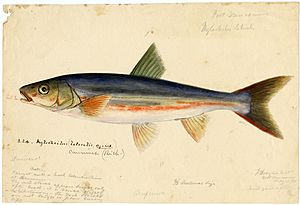Peamouth facts for kids
Quick facts for kids Peamouth |
|
|---|---|
 |
|
| Conservation status | |
| Scientific classification | |
| Genus: |
Mylocheilus
|
| Species: |
caurinus
|
| Synonyms | |
|
|
The peamouth (scientific name: Mylocheilus caurinus) is a type of freshwater fish. It's also known as the peamouth chub, redmouth sucker, or northwestern dace. This fish belongs to the minnow and carp family, called Cyprinidae. You can find peamouth fish in the western parts of North America. It's the only species in its group, called a genus.
Contents
What Does a Peamouth Look Like?
The peamouth is a slim fish with a body that is a bit flat from side to side. Its mouth is on the underside of its head, and it has large eyes and a rounded nose. Its tail is forked, like a "V" shape.
The fish has a dark back and shiny silver belly. Two dark stripes run along its sides. The corners of its mouth are reddish and have small whiskers, called barbels. When male peamouths are ready to breed, they get a bright red stripe along their sides. This red color also shows up on their belly, mouth, gill covers, and the base of their front fins.
The fins on its back and underside each have 8 soft rays. Along its side, it has a line of 66 to 84 scales, which is called the lateral line. Peamouth fish can grow up to about 36 centimeters (14 inches) long.
Where Do Peamouth Fish Live?
Peamouth fish live in western North America. You can find them in the Mackenzie River in the Northwest Territories of Canada. They also live in rivers like the Nass and Peace Rivers in British Columbia. In the United States, they are found in the Columbia River system. This includes parts of Washington state, Oregon, Montana, and Idaho.
These fish can handle a little bit of salty water. This helps them live in rivers on Vancouver Island and other islands off the coast of British Columbia. Some peamouth fish have also been moved to Redwood National Park in California.
Where Do Peamouth Fish Make Their Home?
Peamouth fish like to live in shallow, weedy areas of lakes and rivers. They are most often found among plants in the water. They usually stay close to the bottom, in water less than 18 meters (60 feet) deep. However, in winter, they move to the deeper parts of lakes.
How Peamouth Fish Live
What Peamouth Fish Eat
Young peamouth fish mostly eat tiny crustaceans, which are like small water bugs. Adult peamouths also eat these tiny creatures. But their diet grows to include snails, insects that live in water, and even insects that fall into the water from land. Sometimes, they might even eat a small fish.
Reproduction and Life Cycle
Peamouth fish are ready to have babies when they are 3 to 4 years old. Males usually mature a bit faster than females. They lay their eggs in May and June when the water temperature is between 12 and 18 degrees Celsius (54-64 degrees Fahrenheit).
They lay eggs in streams or along lake shores. They look for shallow areas with gravel or stony bottoms, usually within 1 meter (3 feet) of the bank. The eggs stick to rocks or other surfaces.
A female fish can lay between 5,000 and 30,000 eggs. The number of eggs depends on her age and size. Usually, at least two males will be with one female during spawning. The fish might lay eggs several times in one season.
When peamouth fish gather to lay eggs, it's quite a sight! Many brightly colored fish move into warm, shallow, flowing water in large groups. These big groups attract many animals that eat fish. After the eggs hatch, the baby fish, called fry, form groups near the shore. They move into deeper water later in the summer.
Daily Life and Predators
Peamouth fish might spend their days in deeper water. Then, they move to the shallow areas at night to find food. Many animals eat peamouth fish. These include mammals and birds that eat fish, as well as larger fish species. Peamouth fish can live for up to 8 years.
Peamouth Fish and People
In the past, people used to eat peamouth fish. Today, people still catch them for fun, especially anglers who fish with a rod and line.
In Bellevue City, near Seattle, there's a special online alert system. It tells people when peamouth fish come to local streams to lay their eggs. This way, people who are interested can go and watch this amazing natural event. They get an email when the fish are seen.
Special Cases: Hybrids
Sometimes, peamouth fish can breed with other types of fish. This creates "hybrids," which are a mix of two different species. In Montana, scientists have found hybrids of peamouth fish and northern pikeminnows. They have also found hybrids with redside shiners.
See also
 In Spanish: Mylocheilus caurinus para niños
In Spanish: Mylocheilus caurinus para niños



